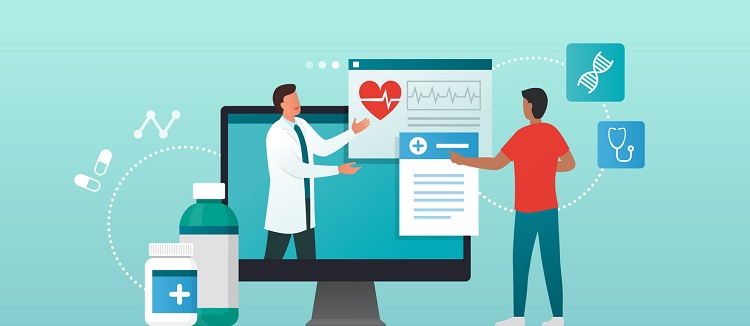Remote patient monitoring (RPM) and the Internet of Things (IoT) in healthcare play an important role in data sharing, enhancing patient outcomes, and cutting costs. For instance, Kaiser Permanente of Southern California reports that only 10% of COVID-19 RPM program participants were hospitalized due to their symptoms. Moreover, they saw a 0.2% mortality rate.
IoT plays a central role in promoting connectivity and data sharing. Together, RPM and IoT seamlessly facilitate the automatic transmission of crucial biometric data like blood pressure, heart rate, pulse, and blood glucose to remote patient monitoring platforms. As an example, IoT enables the daily transfer of data from a Bluetooth or cellular blood pressure monitor directly to a patient’s doctor.
RPM’s primary goal is to provide real-time healthcare value. IoT achieves this by establishing secure connections between patients and healthcare providers. These connections offer instant access to patient data and enable physicians to quickly intervene if complications arise, which leads to multiple benefits for the healthcare industry.
Benefits of IoT in RPM
This article explores the benefits of IoT in RPM. We highlight how IoT enhances RPM to promote preventive care, minimizes patient effort, securely stores patient data, keeps all parties connected, and increases access to healthcare. It emphasizes the positive impact of RPM and IoT on patient outcomes and healthcare cost reduction, offering insights into potential savings for the healthcare industry.
IoT enhances RPM by transforming the way data is shared. It supports a more convenient and value-based approach to healthcare that can benefit patients and clinicians alike. Five key benefits of IoT in remote patient monitoring are included in the following sections.
1) Telehealth, RPM, and IoT Promote Preventive Care
Through IoT, RPM allows clinicians to provide better care between appointments. By closely monitoring how patients are doing outside of the clinical setting in everyday life, care providers identify complications early and focus on preventive treatment. A major feature of RPM and IoT is that remote patient monitoring platforms alert clinicians immediately when a patient’s reading exceeds customized thresholds.
RPM devices prompt care providers to provide medical attention while minimal complications minimize the cost of healthcare admissions and reduce emergency room visits. One study of a large-scale RPM program for COVID-19 patients found that RPM patients had a significantly lower 30-day hospital readmission rate (6.2%) compared to non RPM patients (14.9%). Additionally, RPM successfully captured a higher percentage of higher acuity patients, with 47.7% of RPM 30-day returnees subsequently hospitalized. This research shows RPM’s potential to identify and manage more severe cases effectively.
2) RPM and IoT Require Minimal Effort by the Patient
Another benefit of IoT in RPM is that it requires minimal effort from the patient. Generally, patients won’t comply with a regimen if it is too complicated or time-consuming. IoT enables remote patient monitoring devices to send patient data to the remote patient monitoring portal automatically.
As a result, the process is easier and takes stress off the patient. The patient does not have to worry about writing down information, taking pictures, and sending readings to their clinicians. Additionally, RPM devices do not require pairing with additional software. Instead, they are ready to use right out of the box. This is especially helpful for caregivers providing help to their elderly or Alzheimer’s patients. To ensure Medicare covers RPM, the patient must use the remote patient monitoring device at least 16 days a month.
3) Safely and Securely Stores Patient Data
A major benefit of RPM is that IoT devices transmit patient health data, which are collected and stored. Over time, a detailed patient health history develops. Because of this, clinicians better understand the patient’s condition, enabling better treatment. RPM devices must be FDA-cleared and allow for secure data storage and communication. Additionally, all data is encrypted in transit and storage to ensure patient privacy. Therefore, patients feel assured that their health information will be safe.
4) RPM and IOT Keeps All Parties Connected
The best RPM IoT devices use Bluetooth, Wi-Fi, or cellular technologies to transmit data in real-time. This makes it easy for patients to engage in their health. Patient engagement plays an essential role in determining health outcomes.
Even the most successful treatment plan will not work if the patient does not follow it. However, RPM keeps patients managing their health. They can communicate with care providers more frequently and access the RPM platform whenever they want to stay updated on their health status.
5) Increases Access to Healthcare
IoT enables greater access to RPM services. It focuses on improving the efficiency of the healthcare experience for both patients and clinicians. IoT minimizes the need for travel by enabling secure and automatic data transmission.
As a result, patients comfortably take their vital sign measurements from home and easily share data with their care providers. Care providers can access the RPM portal at their convenience to check how their patients are doing and feel assured that the data is accurate and current.
RPM and IoT Add to the Bottom Line
The National Center for Chronic Prevention and Health Promotion Disease Control Prevention (NCCDPHP) estimates that 90% of the nation’s $4.1 trillion in annual healthcare expenditures are for patients with chronic health conditions. The Internet of Things drives remote patient monitoring into action. RPM through IoT offers a reliable, secure, and efficient way to share patient health data and manage chronic conditions. Therefore, RPM healthcare providers have more opportunities to check patient data between visits. They can care for more patients and focus on early intervention to minimize these healthcare costs and improve patient outcomes.
GlobalData expects the market for IoT platforms catering to healthcare providers will grow steadily.A compound annual growth rate (CAGR) of 4.6% is expected between 2020 and 2025. Furthermore, there’s a promising outlook for spending on IoT within the medical devices market, with an estimated CAGR of 6.6% over the same period.
Are your healthcare partners interested in adopting remote patient monitoring to increase patient engagement, create a more efficient workflow, or increase revenue – Tenovi can help you find a better solution. Book a free RPM demo today.






